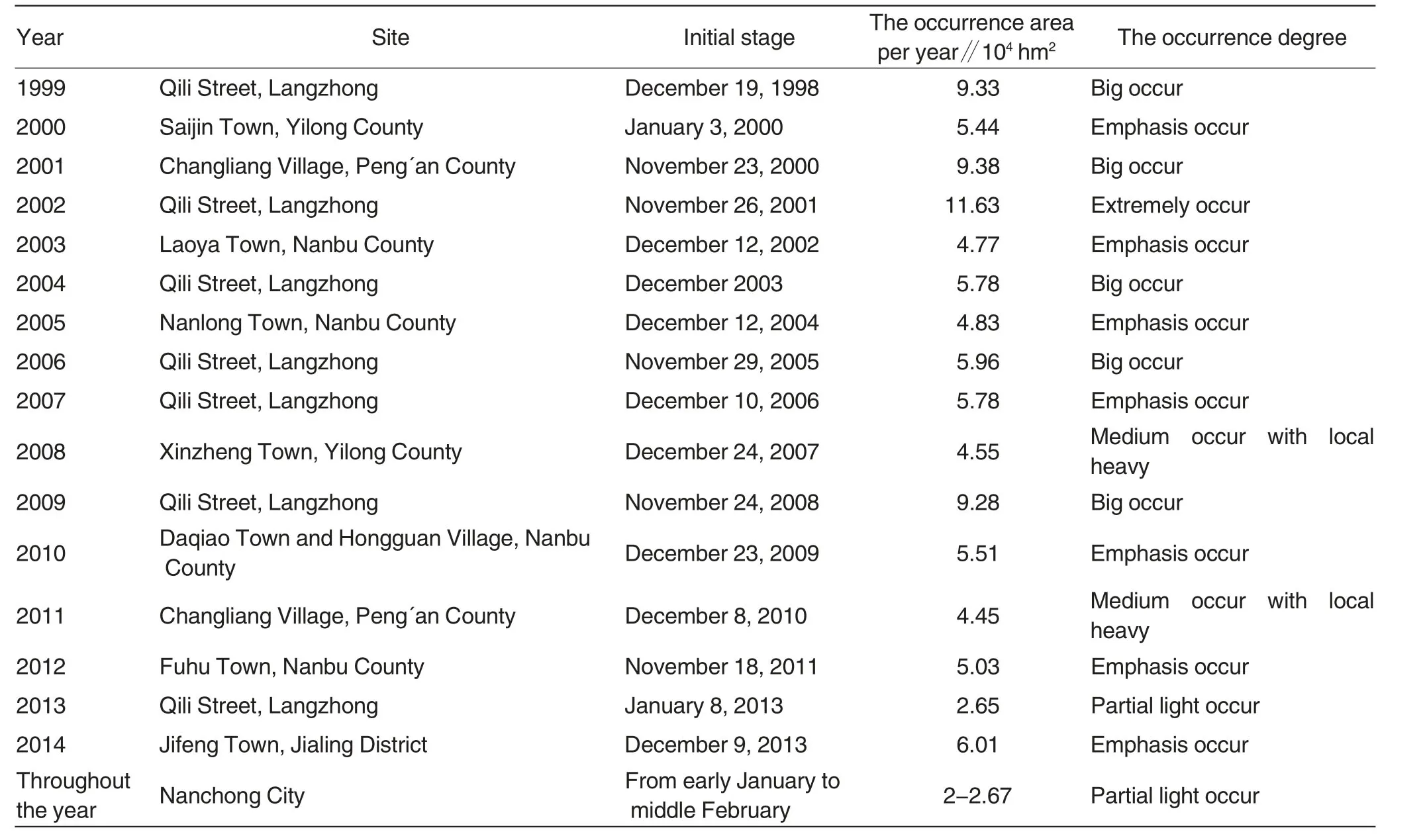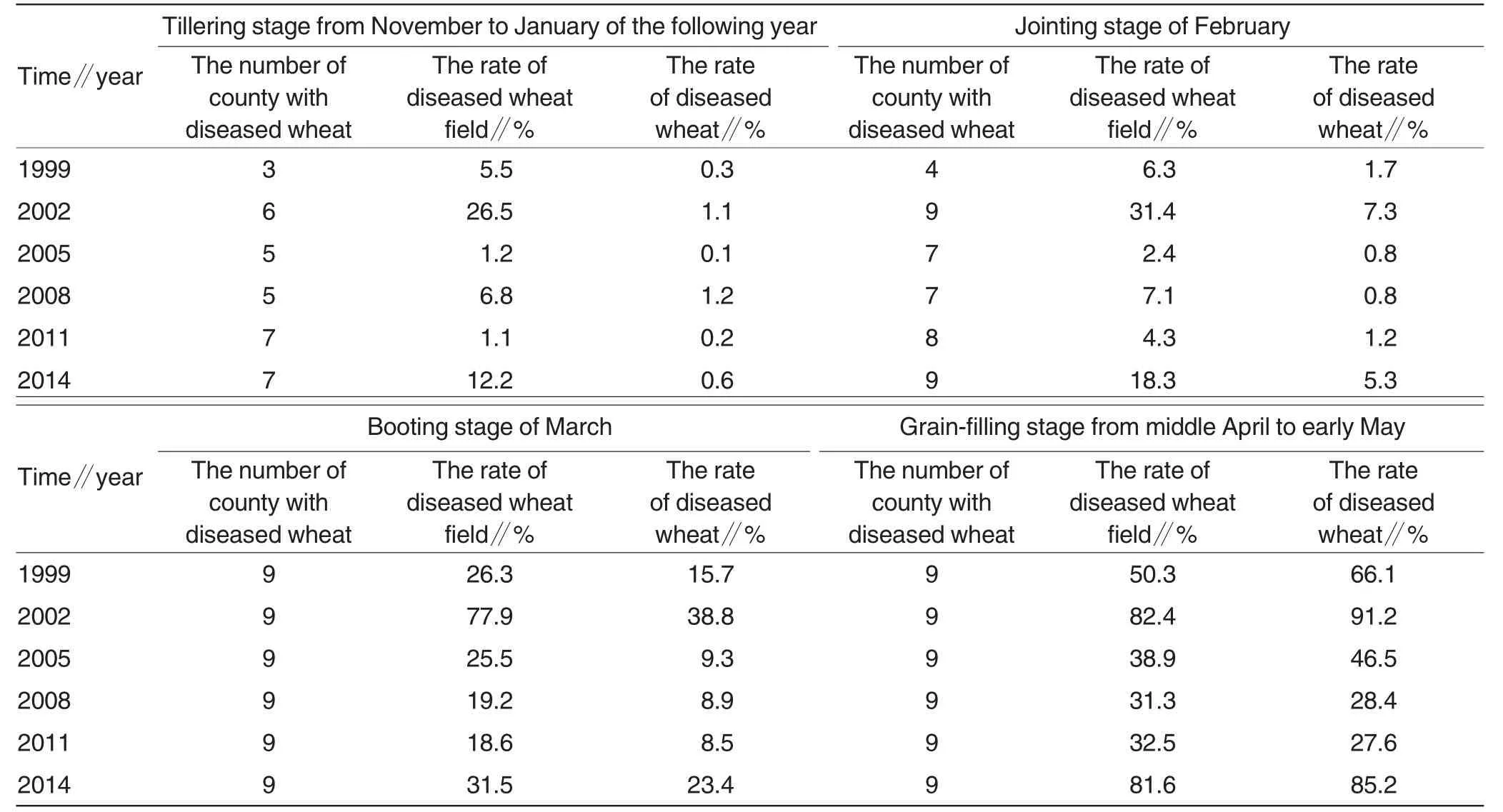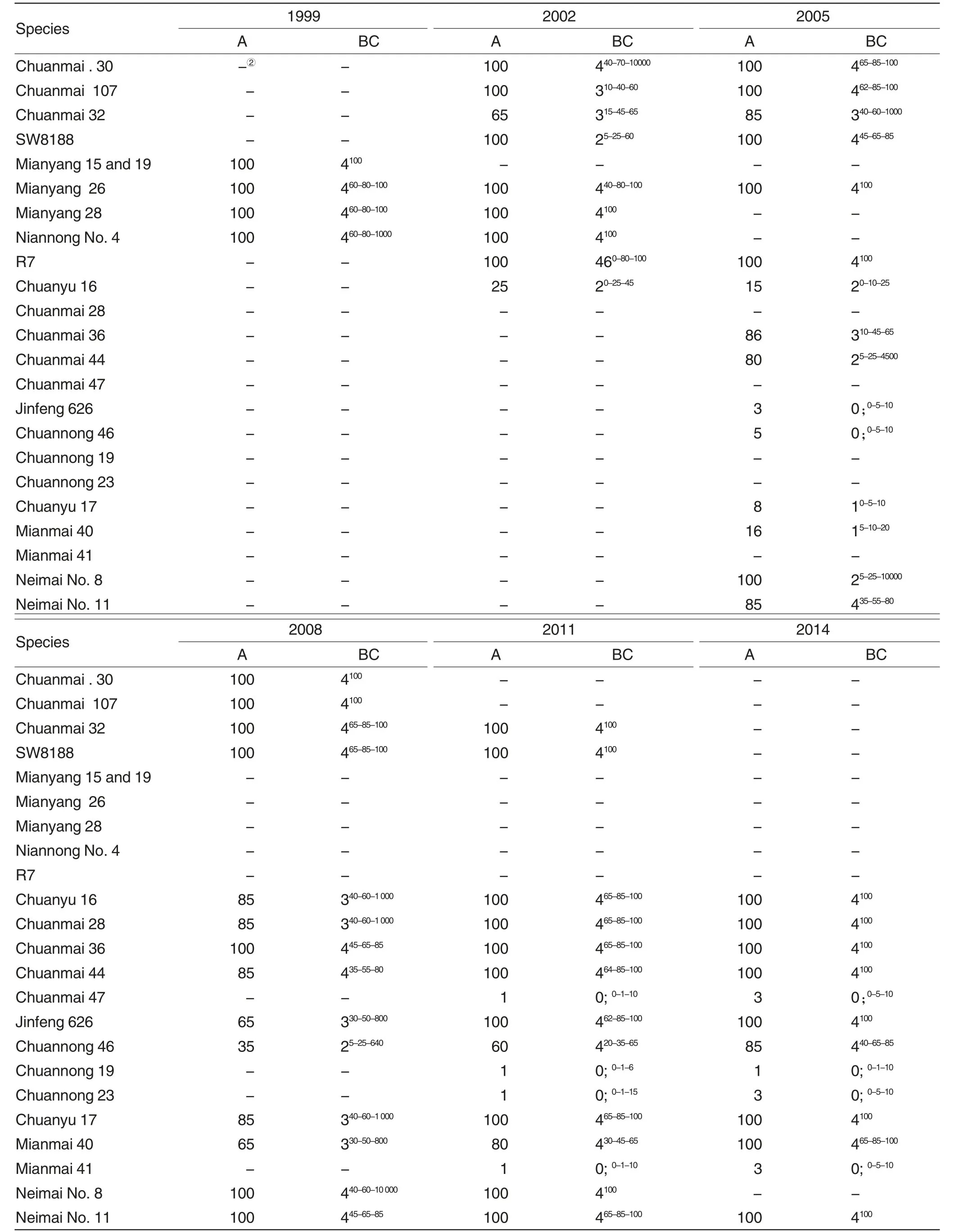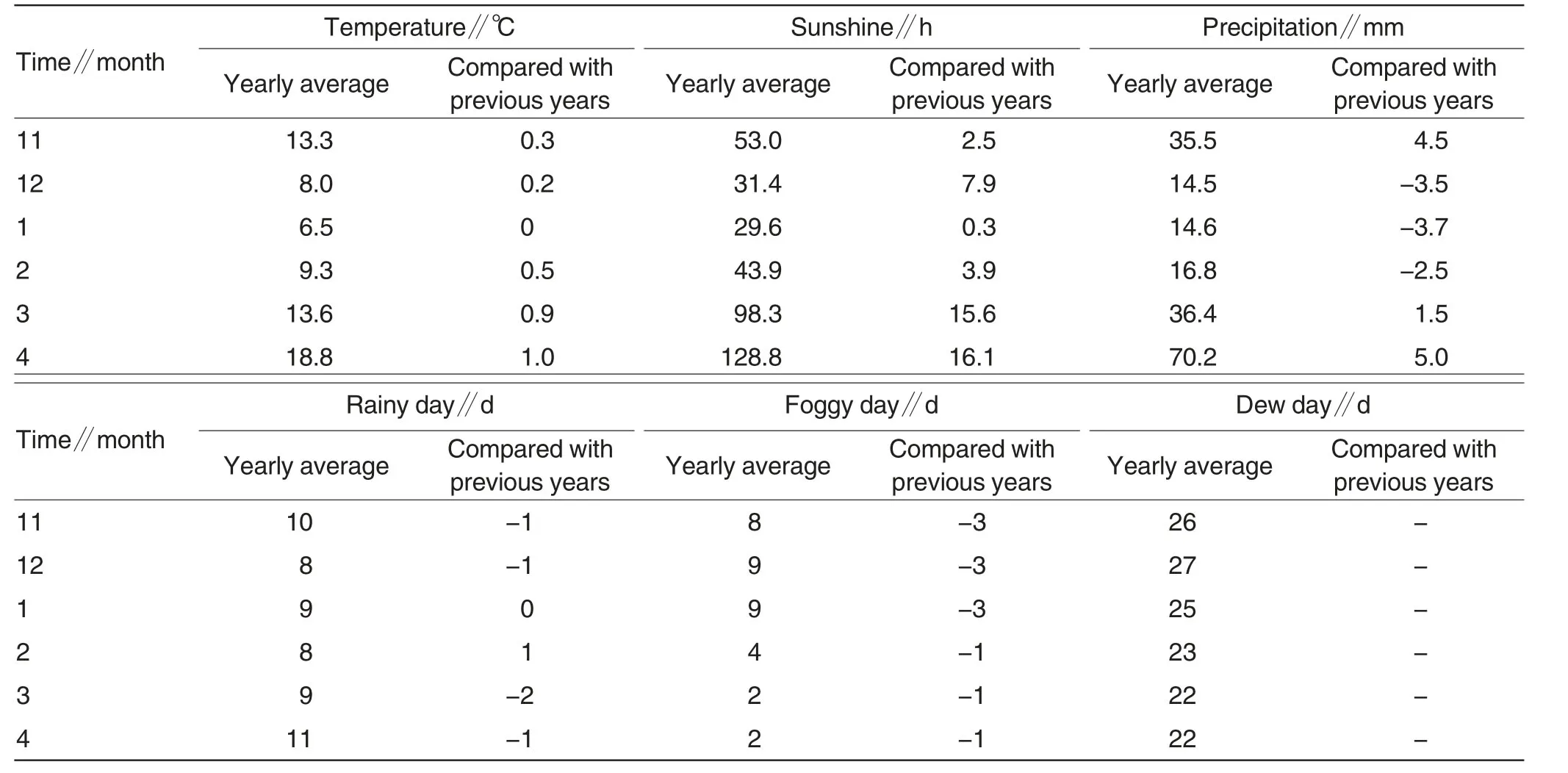Study on Epidemic Characteristics and Its Causes of Wheat Stripe Rust in Nanchong City
Changjia PENG ,Pan DING,Tikun BAI,Libin FENG,Rusheng CHEN,Wanqiu WANG,Huaizhong YIN,Weiguo LONG,Li XIAO,Xu WEN
1.Plant Protection and Plant Quarantine Station of Sichuan Nanchong City,Nanchong 637000,China;
2.Plant Protection and Plant Quarantine Station of Sichuan Yingshan County,Yingshan 638100,China;
3.Soil Manure Station of Sichuan Nanchong City,Nanchong 637000,China;
4.Plant Protection and Plant Quarantine Station of Gaoping District in Nanchong City,Nanchong 637100,China;
5.Plant Protection and Plant Quarantine Station of Sichuan Yilong County,Yilong 637641,China;
6.Plant Protection and Plant Quarantine Station of Jialing District in Nanchong City,Nanchong 637005,China;
7.Plant Protection and Plant Quarantine Station of Sichuan Xichong County,Xichong 637200,China
Responsible editor:Xiaoxue WANG Responsible proofreader:Xiaoyan WU
Wheat is the second mostproduced cereal in Nanchong City,and the area always keeps about 153 000 hm2,accounting for over 33%of crop areas in the city.It is obvious that wheat yield has a considerable effect on total yield of crops here.Nevertheless,wheat is frequently hit by wheat stripe rust with a high frequency (Puccinia striiformis West.F.sp.tritici Eriks et Henn).Without effective controls,the loss rate of annual yield can be as high as 40.0%,and stripe rust has became a major obstacle affecting wheat quality and quantity[1].What’s more,Nanchong is an important breeding area of wheat stripe rust and spring epidemic area in Sichuan province,as well as a fungussource location for wheat diseases occurring in spring in Huanghuai Plain[2-5].Therefore,in order to find out the epidemic rule and improve the timely and accurate monitoring and early warning of wheat stripe rust for providing the scientific basis of comprehensive management and effective prevention.The research made a 16-year survey and research to explore the epidemic characteristics,disease cycle and causes to improve detection and warning of stripe rust and propose effective measures.The summary of this introduction is as follows.
Disease Characteristics and Cycle
The earlier the initial stage,the more serious the disease
According to sowing terms of wheat in the city and weather information from October to February of the following year,since 1998,valleys of Jialing River,Dong River,Gouxi River,Baixi River and West River,the zones along roads,railways and common infection,early infection and severe infection regions were taken as key sites to organize surveys on fields every 3-5 days from November 10 by plantprotection staffs and measurement staffs[6].It is researched that the initial stage of stripe rust was in the range of late November to middle December,which was 40-60 days earlier compared with previous years from 1945-1995 (except for 1950,1956,1958,1962,1964,1975,1983,1985[5]).And it was proved the earlier initial stage,the more serious the disease (Table1).As is shown in Table1,the initial stage in Qili Town,Langzhong City,last as long as 7 years,representing 43.75%,which indicated that the city is an important region where stripe rust is introduced.Furthermore,the initial stage in Nanbu,Yilong and Peng’an Counties can be 15 years,representing 93.75%,which suggested that the source region of stripe rust mainly focuses on Langzhong,Nanbu,Yilong and Peng’an.Hence,the research provides scientific references for monitoring on initial stage of stripe rust,avoiding time consuming or blindness of monitoring in the past.On basis of the research,a long-term warning report could be conducted on stripe rust in previous years,which is not reported yet in China and abroad.
Disease epidemic characteristics Stripe rust with two infection peaks,and the range of infection peaks becoming premises of the severe diseaseWith consideration of incubation period of stripe rust and climate characteristics of wheat (Table2),it can be concluded that stripe rust has two infection periods.Specifically,the first peak is from the tillering stage to jointing stage from November to next February.When external fungus dominates and the rates of fields hit by the disease and of diseased plants keep stable of 1.1% -31.4% and 0.3% -7.3%,respectively.The second peak is in booting stage,which is also an infection peak for Longnan,Aba,winterreproduction regions,as well as Mianyang and Guangyuan[2-5],besides local multiply infected zones,accompanying by rapid growing of diseased fields and plants rates of 18.6% -77.9% and 8.5%-38.8%.It is notable that the infection ranges of the two peaks are premises of the disease epidemics,especially for the first time.For example,in 2002,the diseasedfield rate was as high as 26.5% -31.4%.In accordance with the research of the first introduction of the disease,long and middle-term warning can be made on stripe rust,changing blind analysis in the past,which is not reported yet in China and abroad.

Table1 Initial stage and occurrence area and degree of stripe rust of Nanchong City during 1999-2014
Stripe rust having 1 -3 epidemic peaks in local fields and the peak frequency having direct effects on occurrence degrees of the diseaseThe three epidemic peaks are from middle or late December to late January of the following year (middle to peak tillering stage),from late February to middle March(jointing to booting stage) and from late March to early and middle April (booting stage to grain-filling stage).If wheat suffers the three peaks at the same time,the disease would be much more severe.If two peaks co-exist,the disease keeps moderate or severe.If just one peak occurs,the disease can be determined from moderate to light[1,7-10].As is shown in Table3,the first peak in 2009 was from December 2008 to late January 2009,with an infected area of 206.67 -21 900.00 hm2,the second peak was from late February to middle March,with an area of 42 900.00-64 300.00 hm2and the third period was from late March to middleFebruary with an area of 77 000.00-92 800.00 hm2,accounting for 60.4%ranking first in Sichuan province[4].In 2011,the first peak with moderate disease was from late February to middle March,with an area of 2 933.33-15 253.33 hm2and the second period was from late March to Middle February with an area of 18 420.00-44 466.67 hm2.In 2013 with slight disease,the only peak was from late March to middle April with an area of 14 846.67 -26 520.00 hm2.Meanwhile,on basis of further research of the first peak and the infected area,it can be concluded that the infected area of the first peak decided the disease degree in that year.The more extensive the infected area,the more significant the second and the third epidemic peaks,and the more server the disease will be.It can be concluded from correlation analysis of accumulated area of late January and annual infected area that the accumulated infected areas in late January is of significantly positive correlation with annually infected areas,with correlation coefficient of 0.769 2,which coincided with the frequency of 81.25% in recent 16 years.On basis of the research results,the problem of long or moderate-term warning and predictionon stripe rust can be well resolved.Currently,similar reports are not reported yet in China and abroad except for Chen reported analysis on correlation of epidemicity of the fields hit by stripe rust[11].

Table2 Wheat suffering stripe rust in different growth stages in Nanchong City

Table3 Epidemicity of stripe rust in Nanchong City
It is notable that the prediction and warning in long,moderate and short-term would be much more scientific and accurate with consideration of initial stage,the range of the first introduction of the disease,the infected areas and correlation coefficients of the 1st,2ndand 3rddisease peaks,as well as monitoring data and meteorological prediction.At present,similar reports are not available.According to the data,long,middle and short-term mathematical models can be established for further exploration.
Epidemic trends
In accordance with survey during 1999-2014(Table1),the frequency of severe stripe rust was as high as 81.25% and 50% higher than 1999.The partial light occur stripe rust occurred just in 2013,with a frequency of 6.3%,which indicated that the city has became a region hit by severe stripe rust.
Cause Analysis of the Epidemicity
The tolerance of major wheat varieties to stripe rust
The decline or even loss of resistance of wheat to stripe rust is an internal cause.Since the 1980s,most wheat varieties in the city or even the province were the variety (Fan 6 derivative) with resistance to one disease.After wheat were extensively grown for three decades,the resistance of major varieties loses significantly[14-15],such as Mianyang line[12]and Chuanmai[13],covering Mianyang No.15,19,26 and 28,and MiannongNo.4[1,3-5,7-10,12-15].As for newly-approved varieties,mostly are Blood varieties of Fan 6 which fail in extensive application,although perform well in regional tests,such as Chuanmai,Mianmai,Chuannong and Neimai[5,16].As is shown in Table4,however,Chuanmai No.47,Chuannong No.19 and 23,and Mianmai No.41 were all performed better in resistance since 2011,which coincided with the research of Han et al.[17]and Xu et al.[18].

Table4 Occurrence of stripe rust on wheat varieties in Nanchong City①

Table5 Meteorological data of Nanchong City during 1998-2014
Pathogenicity of physiological races of stripe rust
The pathogenicity of physiological races proves high and become a direct cause of wheat’ loss of resistance.According to Institute of Plant Protection and Station of Plant Protection,Sichuan Academy of Agricultural Sciences,the pathogenicity of Tiaozhong No.30,31,32 and 33,and Shuiyuan 11 was higher,and kept increasing[3-5,12-15].In 2013,an identification was conducted on 122 stripe rust samples and the results indicated that the frequency of different physiological races of Hybrid 46 totaled 67.21%,of which Tiaozhong No.32 was of the highest frequency of 19.67%,and the frequency of Tiaozhong No.33 was 10.66%.The two were both with high pathogenicity in Sichuan but still the fine races[18].
Weather conditions of warn winter and spring
The large fluctuations of warm winter and spring and more foggy or dew days have a direct effect on wide epidemics of stripe rust.As is shown in Table5,from November to April of the following years during 1998 -2014,average monthly temperature in the city was 0 -1.0 ℃higher compared with previous years.The average sunshine was 0.3-16.1 h more compared with previous years and the number of dew days accounted for 71.0% -87.1%.Foggy days from November to January of the following year represented 26.7% -29.0% of different months and rainy days were 1-2 days fewer in November-December and March-April,compared with previous years and 0-1 day more in January-February.The average precipitation was 2.5-5.0 mm fewer(except for March in which the precipitation was 1.5 mm more).Though with little precipitation,foggy days and dew days were more,so that humidity of farmlands maintains higher.For example,the dew on wheat usually maintains in afternoon in winter days,promoting infection of spores.In January,the average temperature is just 6.5 ℃,which has insignificant inhibition on infection of the spores.Before or in middle of wheat growth,the city is dominated northwest wind and northerly wind with high wind power (the largest wind power reached 6.7-8.0 grade),advancing pathogenic bacteria extension in the whole city.From middle March to middle April,temperature tends to be volatile,and wind power increases,resulting in twice introductions of the bacteria,followed by rapid extension.What’s worse,the proper temperature is beneficial for spore growth in the period when maximal winds are as high as 6.5-8.7 grades in winter propagating areas such as Mianyang and Guangyuan,etc.which promoting the extension of the diseases.
On the other hand,the researches in the 16 years indicated that the occurrence time of stripe rust can be extended to early May,and even in middle May,due to lasting low temperature in spring and frequent cold waves.For instance,the extremely occur stripe rust in 2002[8],and emphasis occur in 2010[10]and 2014.Because of the low temperature and frequent cold waves the occurrence time last for middle May.The research monitored that fresh spores can be found on May 15,in the fields where wheat were not well protected.
Conclusions
Based on research of early stage,epidemic characteristics and conditions,the causes and development of the city were analyzed,and the warning and monitoring of stripe rust could be improved for long,middle and short-term predictions with consideration of infection range of the first introduction,correlation coefficients of the occurrence areas of three peaks,as well as field monitoring data and meteorological prediction.According to the statistics,since 2002,The shortterm prediction accuracy rate of wheat stripe rust was 100% in every year while the medium and long-term prediction accuracy rate reaching more than 98%and 95%respectively,which increased by 5-15 percentage points than those before 1998.
[1]DU XY(杜曉宇),OU XY(歐曉陽).Causes and countermeasures of stripe rust in Nanchong City (南充市小麥條銹病流行成因及治理對策)[J].Plant Protection(植物保護),2004,30(4):65-68.
[2]SHEN L(沈麗),LUO LM(羅林明),CHEN WQ(陳萬權(quán)),et al.Epidemic zones and dispersal routes of wheat stripe rust caused by Puccinia striiformis West.in Sichuan(四川省小麥條銹病流行區(qū)劃及菌源傳播路徑分析)[J].Acta Phytophylacica Sinica (植物保護學(xué)報),2008,35(3):220-226.
[3]YAO G(姚革),JIANG B(蔣濱),TIAN CQ(田承權(quán)),et al.Epidemic and control strategies of wheat stripe rust in Sichuan,China(四川省小麥條銹病持續(xù)流行原因及防治對策)[J].Southwest China Journal of Agricultural Sciences(西南農(nóng)業(yè)學(xué)報),2004,17(2):253-256.
[4]LUO LM(羅林明),SHEN L(沈麗),LIAO HM (廖華明).Strategies and measures of integrated management of Puccinia striiformis West.in Sichuan Province(四川小麥條銹病菌源地綜合治理對策與措施研究)[C].Prevention and control agricultural biological disasters (《農(nóng)業(yè)生物災(zāi)害預(yù)防與控制研究》M.),CHENG ZM(成卓敏),China Agricultural S&T Press(中國農(nóng)業(yè)科學(xué)技術(shù)出版社),2005:171-174.
[5]SHEN L(沈麗).Studies on epidemiology of wheat stripe rust and its ecological control in Sichuan Province(四川省小麥條銹病流行規(guī)律及生態(tài)控制研究)[D].Beipei:Southwest University(北培:西南大學(xué)).2008.
[6]ZHANG YJ (張躍進).A handbook of forecast technology of harmful insects on crops (農(nóng)作物有害生物測報技術(shù)手冊)[M].Beijing:China Agriculture Press(北京:中國農(nóng)業(yè)出版社),2006.
[7]PENG CJ (彭昌家),DING P (丁攀),TANG GM(唐高民),et al..Characteristics and countermeasures of stripe rust in 2009 in Nanchong City (南充市2009年小麥條銹病大發(fā)生的特點及成功防控措施)[J].China Plant Protection(中國植保導(dǎo)刊),2009,29(10):24-27.
[8]PENG CJ (彭昌家).Analysis on cause and comprehensive treatment of stripe rust in Nanchong City (南充市小麥條銹病流行原因分析及綜合治理探討)[J].China Plant Protection (中國植保導(dǎo)刊),2004,24(1):24-27.
[9]PENG CJ (彭昌家),DING P (丁攀),TANG GM(唐高民),et al.The systematic control technology of stripe rust in Nanchong City (南充市小麥條銹病系統(tǒng)控制技術(shù)研究)[J].Forum on Science and Technology in China (中國科學(xué)論壇),2008,113(12):1-4.
[10]PENG CJ(彭昌家).Cause analysis and countermeasures of stripe rust and gibberellic disease in Nanchong City in 2010 (南充市2010年小麥條銹病和赤霉病重發(fā)原因分析及其防控措施)[J].China Plant Protection(中國植保導(dǎo)刊),2010,30(12):19-22.
[11]CHEN G (陳剛),WANG HG (王海光),ZHANG LD(張錄達),et al..Preliminary research on the relationship of epidemic of Puccinia striiformis in China(小麥條銹病區(qū)域流行相關(guān)性研究初報)[J].Chinese?Agricultural Science Bulletin(中國農(nóng)學(xué)通報),2006,22 (7):415-420.
[12]NIU YC(牛永春),WU LR(吳立人).Variation and countermeasures of Fan 6,Mianyang line,tolerance against stripe rust (繁6—綿陽系小麥抗條銹性變異及對策) [J].Acta Phytopathologica Sinica(植物病理學(xué)報),1997,27(1):5-8.
[13]YANG JX(楊家秀),LIU SY(劉述英).Identification of major wheat varieties’tolerance against stripe rust(四川小麥主要生產(chǎn)品種(系) 分小種抗條銹性鑒定)[J].Journal of Southwest Agricultural University (natural science)(西南農(nóng)業(yè)大學(xué)學(xué)報(自然科學(xué)版)),1996,18(6):550-553.
[14]LIU K(劉可),Shen L(沈麗).Features of the epidemic of wheat stripe rust in 2002 in Sichuan and the causes underlying it (四川地區(qū)小麥條銹病大流行特點及原因分析)[J].Journal of Southwest Agricultural University (natural science)(西南農(nóng)業(yè)大學(xué)學(xué)報(自然科學(xué)版)),2002,24(4):299-302
[15]SHEN L(沈麗),QIN Z(秦蓁),PENG YL(彭云良),et al..Current situation of the resistance of wheat cultivars to stripe rust and its management measures in Sichuan province (四川省小麥品種抗條銹現(xiàn)狀及對策措施)[J].China Plant Protection (中國植保導(dǎo)刊),2007,27(10):9-11
[16]WAN AM (萬安民),WU LR (吳立人),JIN SL (金社林),et al.Occurrence of wheat stripe rust and monitoring of physiological races of Puccinia striiformis in China in 2000-2001 (2000-2001年我國小麥條銹病發(fā)生和生理小種監(jiān)測結(jié)果)[J].Plant Protection (植物保護),2002,28(3):5-9.
[17]HAN DJ(韓德俊),WANG QL(王琪琳),ZHANG L (張立),et al.Evaluation of resistance of current wheat cultivars to stripe rust in northwest China,north China,and the middle and lower reaches of Changjiang River epidemic area(“西北-華北-長江中下游” 條銹病流行區(qū)系當前小麥品種(系)抗條銹病性評價)[J].Scientia Agricultura Sinica(中國農(nóng)業(yè)科學(xué)),2010,43 (14):2889-2896.
[18]XU Z (徐志),ZHANG ZY (章振羽),NI JY(倪健英),et al.Resistance of major wheat cultivars to stripe rust and powdery mildew in field and genetic analysis with SSR marker(四川省小麥品種對條銹病和白粉病的田間抗性表現(xiàn)及其SSR 遺傳分析(摘要))[C].Ecological civilization construction and plant protection-proceedings of China Society of Plant Protection in 2014(《生態(tài)明建設(shè)與綠色植?!袊脖W(xué)會2014年學(xué)術(shù)年會論文集》),CHENWQ(陳萬權(quán)),China Agricultural S&T Press (中國農(nóng)業(yè)科技出版社),2014:363.
 Agricultural Science & Technology2015年2期
Agricultural Science & Technology2015年2期
- Agricultural Science & Technology的其它文章
- Thoughts and Exploration on Transformation and Upgrading of Tobacco Production Promoted by Lean Management
- Bottleneck of Modern Agricultural Development and Countermeasures in Qinzhou in the Context of Beibu Gulf Economic Zone
- Preliminary Study on Effects of the Model of Community-supported Agriculture(CSA)on Urban-rural Income Gap in China
- Research on Micro-vibration Generator for Powering Tire Pressure Alarm System
- Spices and Food Culture in Native Minorities of Dehong
- Advance in Rice Bacterial Leaf Streak Researches
